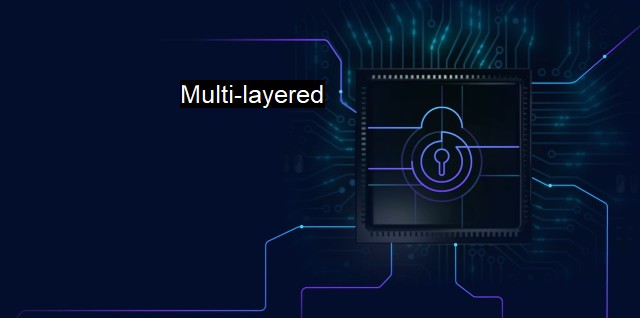What is Multi-layered?
Exploring the Benefits of a Multi-Layered Approach to Antivirus for Comprehensive Cybersecurity Protection Against Advanced Threats
In the sphere of cybersecurity and antivirus defenses, the concept of "multi-layered" security emerges as a dynamic, intelligent, and effective approach focused on defending various avenues that could potentially lead to a breach. The term signifies the application of numerous strategies, utilities, or techniques in concert to impede digital intruders' progress and stymie a wide variety of threats before they can inflict damage to the core system, data, and network resources.Multi-layered security solutions often integrate individual layers of defenses that function autonomously to fit individual security requirements. These separate layers may include anything from firewalls and antivirus to intrusion detection systems (IDS), intrusion prevention systems (IPS), and secure gateways. Each layer is designed to spot a particular type of threat or vulnerability, adding an additional layer of protection that makes it exponentially more difficult for attackers to succeed.
Here, antivirus protection becomes one significant layer. It scans, detects, and removes viruses and other malicious software from devices by archiving, analyzing collected data, and fixing threats based on their signatures or behavioral patterns. Antivirus tools can either remove or isolate the threats once discovered, thus preventing them from causing damage to the infrastructure. As part of a multi-layered approach, antivirus helps ensure that even if a threat bypasses other security measures, it may still be caught during its final phase.
In addition to antivirus measures, a multi-layered cybersecurity strategy often includes firewalls that control incoming and outgoing network traffic based on predetermined security rules safeguarding the internal networks protected from external threats. Similarly, intrusion detection or prevention systems serve to identify suspicious activity within the network by monitoring the activities as another layer of security, alerting administrators to any potential security risks, thereby preventing cyberattacks.
The principle of multi-layered security can also introduce elements such as email and web content filters, privacy controls, and good cybersecurity hygiene practices such as regular software updates and security patches. Other special tools like advanced anomaly detection, data loss prevention software, or security information and event management (SIEM) solutions can be incorporated as part of this layered scheme for maximum protection and compliance.
No system, as robust as it may be, is utterly impervious to potential breaches. This is where a good disaster recovery plan is key. This incorporates measures ensuring minimal data loss and downtime in case of a system compromise; another intricate element of multi-layered security.
A multi-layered approach inherently increases the complexity and difficulty for intruders to bypass the system; every layer an attacker breaks through throttles their access or completely inhibits them, which potentially discourages them. Ideally, this approach prevents attacks, and when it can't, it should at least limit the damage.
"multi-layered" refers to a guarded and comprehensive strategy that proactively manages, assesses, and eliminates threats at numerous discrete levels. Consequently, it provides an imperative defense model enhancing the overall security of the infrastructure from a multitude of cyber threats. By focusing on multiple individualized layers, each with its designated role, the cohesive functionality of a multi-layered security structure provides depth to the corporate defense strategy, empowering businesses and organizations of all sizes, making them more impervious and resilient against resilience cyber threats.

Multi-layered FAQs
What is meant by "multi-layered" in cybersecurity and antivirus?
In cybersecurity and antivirus, "multi-layered" refers to a comprehensive approach that involves multiple layers of protection for a system or network. This approach involves combining various security measures to provide better protection against threats.What are some examples of multi-layered cybersecurity measures?
Multi-layered cybersecurity measures can include firewalls, intrusion detection and prevention systems, anti-virus and anti-malware software, user authentication, access control, data encryption, and security awareness training.Why is a multi-layered approach important in cybersecurity and antivirus?
A multi-layered approach is important in cybersecurity and antivirus because it provides a more robust defense against threats. Relying on a single security measure may not be enough to protect against all types of attacks, and a multi-layered approach can help to fill any gaps in a system's defenses.How can I implement a multi-layered approach in my organization's cybersecurity and antivirus strategy?
To implement a multi-layered approach, start by conducting a thorough assessment of your organization's existing security measures. Identify any gaps or vulnerabilities that need to be addressed, and then develop a plan to layer additional security measures to strengthen your defenses. This approach may involve investing in new security technologies, updating policies and procedures, and providing training to employees to raise awareness about cybersecurity best practices.| | A | | | B | | | C | | | D | | | E | | | F | | | G | | | H | | | I | | | J | | | K | | | L | | | M | |
| | N | | | O | | | P | | | Q | | | R | | | S | | | T | | | U | | | V | | | W | | | X | | | Y | | | Z | |
| | 1 | | | 2 | | | 3 | | | 4 | | | 7 | | | 8 | | |||||||